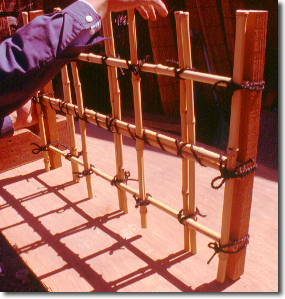The Yotsume-gaki 四目垣 is a well-known style and one of the easiest to build. This is a great fence to learn a little about cutting, drilling and tieing bamboo. The photos are taken at Otsuka Bamboo in Kyoto, Japan. For a demonstration of Japanese fence knot, see Otoko musu.

Mr. Yuji Otsuka marks the upright post boards with the desired heights for horizontal culms. This varies according to the height of the fence.

A sharp bamboo saw is used with a cutting box to aid in making a smooth straight cut.

Cutting the vertical culms at a node prevents the cut pieces from collecting water. Therefore, the upper end is selected and cut before measuring the length for bottom cuts.

The oshibuchi 押縁 or horizontal culms are selected paying attention to node placement. You will want to position nodes aesthetically while avoiding conflicts with vertical pieces.

Once the horizontal culms are selected and positioned, they are predrilled for attachment to the posts.

Here, the horizontal culms are attached using 6p galvanized ring-shank nails. Drive them just until snug. Do not crush or crack the culms as this will weaken and reduce the life of the fence.

This time, the kakiko 垣子 or vertical culms are selected for node position. Remember you want to end up with a cut just above a node at the top of vertical culms.

The end and center vertical culms are spaced within the section and tied. See Otoko musu to watch a video on how to tie the knot. (Notice the bamboo saw-horses?)

Here you can see that the opposite side culms have been experimentally placed to aid in design decisions.

Now the opposite side double culms are placed. It is easy to see the node cuts at the top of these culms.

The culms can be tied with thin copper wire and overtied with the black palm rope to insure a longer lasting tie

Otsuka-san is now wrapping the center two horizontal culms and securing the vertical culms. Notice the double cross through the double vertical culms.

The finished model. If desired, it is possible to construct the sections with the aid of a bench or other work area, then transfer them to the permanent posts in the garden.
For a video on Simple Japanese knots, see Otoko-musu.
Don Pylant, Kyoto Japan, 2001


